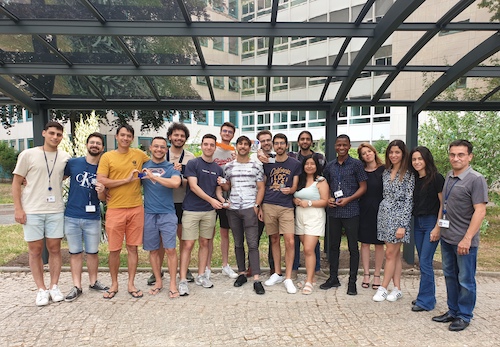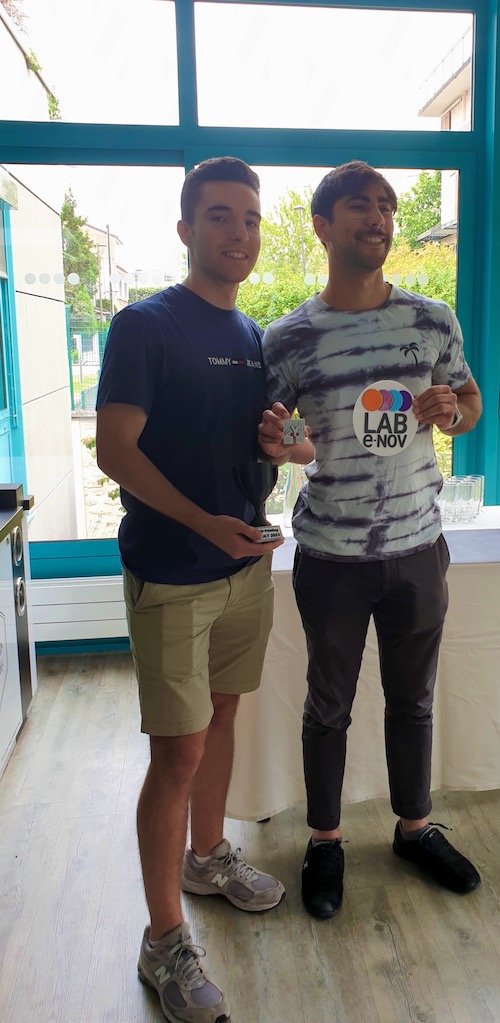The "by the students, for the students" teaching approach at IFP School prepares future specialized engineers for the professional challenges they will face, emphasising collaborative learning and hands-on practice. The 3D printing day organised by the 3D printing club is a concrete example of this approach, which has been in place since 2023. This event allows students to develop systems within the framework of their applied projects. Designed as a hackathon, this event encouraged students to work together on activities and games, earning points to win a trophy.
The goal? To make learning dynamic and engaging, with activities ranging from computer modelling to printing parts. The event took place in the Lab e·novTM premises, with teaching support from the team. The program aimed to help students create concepts for their future projects, as part of the Processes and Polymers program.
The interactivity and engagement of students during this event confirm the value of diversifying teaching approaches. In this article, we share the event's structure and content to highlight the benefits of this method for training future engineers.
Activity Overview
The 3D printing day at IFP School was designed as a hackathon, a collaborative competition where participants, divided into teams, work intensively on specific projects within a limited time. This fun approach makes learning both dynamic and interactive. The scope of work ranged from designing a part to printing it, with various small activities and games interspersed.
Each activity was designed to allow students to earn points, with a trophy awarded at the end of the competition to the highest-performing team.
Instead of remaining passive behind a screen or in front of a traditional lecture, students actively participated in every step of the process. They began with 3D modelling on computers, learning to design parts while considering the constraints of collaborative creation. This was followed by the actual printing of the parts, allowing students to see the tangible result of their digital work.
Learning 3D printing is particularly useful in technological development activities in companies, as it offers the opportunity to quickly create and test concepts at reduced costs and timelines. By learning to model and print parts, students gain valuable expertise for demonstrating the feasibility of their ideas on a small scale.
The Processes and Polymers program includes a day dedicated to 3D printing, usually taught by an industry professional. This time, however, the session was led by students from the 3D printing club. To fulfil their mission, they were supported by the Lab e·novTM team, which helped them structure and lead the day using fun tools such as games and challenges.

Games and Challenges Dynamics
The activities were designed to actively engage students throughout the process. By participating in these activities, students had the opportunity to model 3D parts using CAD software and print them, thus seeing the tangible results of their digital work.

This approach met several educational objectives:
1. Collaboration and teamwork: Strengthening communication skills, task coordination, and teamwork—key in professional environments.
2. Problem-solving: Encouraging students to find creative and practical solutions while adhering to functional specifications and optimizing design, thus enhancing their problem-solving abilities—an essential skill for engineers.
3. Practical application of knowledge: Working on concrete projects allows students to experiment and apply theoretical concepts learned in class to real-life situations, leading to a better understanding and mastery of technical knowledge.
4. Time management: Students had to effectively manage their time to optimize their concepts before the competition ended, another critical project management skill.
These games and challenges had significant learning value: by immersing themselves in a realistic and active learning environment, students were responsible for their projects from start to finish. The use of games and simulations in higher education has demonstrated numerous educational benefits: games promote motivation, interaction, feedback, and collaborative learning, facilitating knowledge acquisition.
Challenges to Overcome: Advice for Teachers
The implementation of the "by the students, for the students" approach can present challenges for both teachers and learners. Here are some tips to overcome these obstacles:
1. Advance Planning: Teachers must meticulously organize the educational content and logistical aspects of the event. This includes reserving appropriate spaces, such as the Active Learning rooms at Lab e·novTM and providing the necessary equipment for 3D printing. Detailed preparation is essential to ensure the smooth running of the day.
2. Student Engagement: Identifying and motivating students who will lead the initiative is crucial. They must not only master the technical skills related to 3D printing but also develop teaching skills to effectively share their knowledge with their peers. Ensure that you select passionate individuals who can fully invest themselves in this task.
3. Gamification of Learning: Designing engaging activities and games that maintain participants' interest throughout the day is a real challenge. Creating a point system and a final competition requires in-depth thinking about game design. Activities should be both educational and enjoyable to encourage active participation and student engagement.
4. Interactive and Collaborative Environment: It is essential to maintain an environment conducive to interaction and collaborative learning. Organisers must encourage active participation at every stage and ensure that all students understand and respect the rules and objectives of the activities. Cultivating a spirit of mutual aid and collaboration can truly enhance the learning experience.
Conclusion
The 3D printing day at IFP School, organized as a hackathon, demonstrated the effectiveness of the "by the students, for the students" approach. This initiative allowed participants to immerse themselves in an active and collaborative learning environment, where they were responsible for their projects from start to finish.
This dynamic fostered collaboration, problem-solving, practical application of knowledge, and time management—key skills for future specialised engineers from the School.
Feedback has been very positive. The students who facilitated the day appreciated the recognition of their expertise and the opportunity to share their knowledge. The learners showed great attention and participated actively, thereby creating an interactive and collaborative environment. Furthermore, the responsible teacher noted the success of this teaching approach, emphasizing the importance of sustaining it.
However, implementing this method has posed challenges that can be overcome with good prior preparation. This experience at IFP School illustrated how a fun and collaborative teaching approach can enrich students' learning, effectively preparing them for the demands of the professional world. This experience shows that, despite the challenges, peer learning—by the students for the students—can be beneficial and should be encouraged in higher education.
Article written by Jérémy Demolliens, Head of the Immersive Realities hub at Lab e·novTM